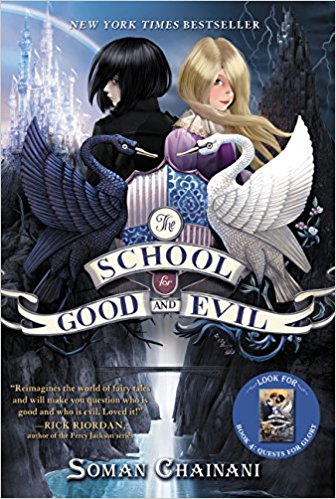I was looking for fantasy books for my students to read, and stumbled upon this while I was browsing through GoodReads. Basically, the story revolves around two girls, Sophie and Agatha, who live in an old medieval village. Although Sophie is conventionally good-looking, she’s quite selfish. On the other hand, Agatha, who is shunned, does her best to be a good person. Every year, two students go missing, and the villagers find out that they’re sent to the School for Good and Evil to become the princesses, princes, witches and villains in fairytales.
Spoilers below. Tread with caution.
The book started off well and the two girls are sent to both schools. Surprisingly, (or rather, unsurprisingly,) Sophie goes to the School of Evil and Agatha to the School of Good. At the first school, they learn how to cast spells and trick heroes, while the syllabus of the School of Good is all about, appearances, developing altruism, and getting married to the prince/princess of your dreams. If you were a boy, you’d have to learn how to be a hero and fight with a sword, while villainous boys have to harness their powers (there’s a wereboy of sorts, I think, in the book.)
Initially, it was fun to see both Sophie and Agatha fail their classes, and then slowly get the hang of it. The other supporting characters, like Hester, the witch with a tattoo on her neck, Anadil, the albino witch, and Dot, were excellent as support. Since Agatha wants to go home and Sophie wants to win Tedros’ heart, the schoolmaster gives them a riddle to solve.
Then, there’s Tedros, who complicates things. The son of King Arthur enters and Sophie falls for him immediately, despite being from the School of Evil, and more importantly, being a witch. Agatha despises him as well, but loves Sophie enough to help her with homework and challenges so that she will be able to win Tedros’ heart. Since both schools compete in the Trial by Tale, which is kind of like a fairytale-style Hunger Games. Sure enough, Agatha and Sophie figure out the answer to the riddle and Agatha decides to help Sophie win Tedros’ heart so that they can both get what they want — Sophie getting a Prince, and Agatha going back home.
While it was great to see the author using the book to critique how silly and stifling fairytale tropes are, this book could have pushed more boundaries with regards to gender and touch on more moral grey areas. Instead, it got bogged down by clunky storytelling and it was fairly obvious that the writer and publisher were going to make this book a bankable series with additional lore and details. However, it was refreshing to see a different take of a happy ending, or a different take of true love’s kiss.
This is definitely a fun book for students who are 10-12 years old, especially if they like reading books about fairytales.
